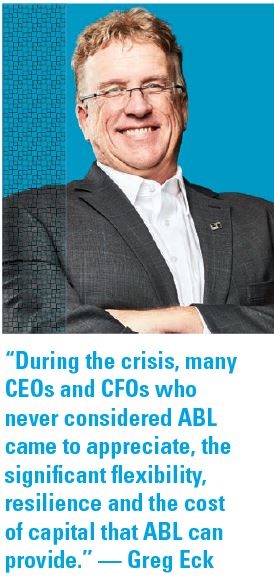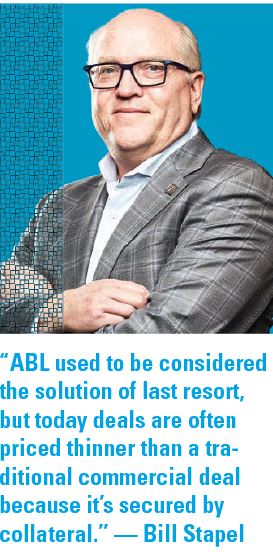- Singing Machine Company Secures $15.0 Million Senior Secured Financing with Fifth Third Bank
- CIT Launches New Golf & Turf Equipment Leasing and Financing Vertical
- Ares Commercial Finance Served as Lead and Agent for the Financing of a $210 Million Senior Secured Cross-Border Revolving Line of Credit to MicroStar Logistics
- CIT Announces New Organizational Structure for Factoring Business
- First Citizens Bank Serves as Lead Arranger on $211 Million Financing for North Carolina Solar Power Development
Bill Stapel and Greg Eck, New Leaders of Fifth Third Bank Asset-Based Lending Group, Share Vision for 2021
By Michele Ocejo
Greg Eck and Bill Stapel are the new leaders of the ABL Group at Fifth Third Bank, N.A., one of the nation’s largest asset-based lenders, with $8.1 MM in commitments and serving customers in 38 states, Canada and Europe. They step into their roles following the retirement of Fifth Third Business Capital President Mike Sharkey, who was also past president and chairman of Secured Finance Network.
Eck and Stapel couldn’t be better suited for their new roles. Not only did both begin their careers in Chicago, but they also started as trainees at Heller Financial – on the same day in 1986. From there, each built a career in a different direction, but now together again, they bring a combined experience in virtually every aspect of asset-based lending. Eck and Stapel are leading teams of experienced professionals who provide comprehensive asset-based lending solutions to companies across the spectrum of size, location and industry.
Five years ago, when Fifth Third Bank entered the ABL market, Eck was brought on board as the team’s first leader. Today, he puts to work his extensive experience in sales, underwriting and portfolio management, much of it gained at Bank of America and GE Capital, where he was responsible for a broad array of middle market/large corporate customers. He now leads an ABL-team, many who migrated to Fifth Third Bank with him. Together, they serve middle-market/ large corporate companies as they implement strategies for organic growth, turnaround and mergers/acquisitions.
Stapel joined Fifth Third Bank in early 2019 with the acquisition of MB Financial Bank, which included a robust national ABL business. He was part of the senior management team that Mike Sharkey had built over decades at various banks, most of who remain an integral part of Stapel’s team.
Growing up in a family-owned Wisconsin hardware business means Stapel offers customers his unique perspective as a business owner. That background also gives him an understanding of the dips in every business cycle and the patience required when a business is experiencing an adverse situation. As the team works with customers on the road back to good health, he sees ABL as “a great tool for middle-market businesses, giving them the financing resources to support growth and address pressing liquidity needs.”
Please tell us how you and your teams work together.
ECK: At Fifth Third Bank we take a holistic approach – unlike some organizations whose ABL teams work in silos defined by industry segment, geography or size. We know what’s important is meeting our customers’ and prospects’ needs and applying our creativity, industry expertise and ABL experience to accomplish that. So our teams collaborate to ensure clients get the solutions they need.
STAPEL: At the end of the day, you get the right solution at Fifth Third Bank, no matter who you call.
As you look toward the coming year, what’s ahead for your customers?
STAPEL: We are stepping into our new positions at a time when the nation and the world are adapting to new challenges. Companies are now reevaluating their businesses, including fresh looks at growth plans and their strategies for moving forward. That said, we’re seeing sales increase from the low point in May 2020, but we won’t know if the worst is behind us until we fully evaluate fourth quarter numbers. The Payment Protection Program, leveraged as an invaluable funding resource by many lower middle-market companies during the pandemic, could delay change of control or refinancing transactions going forward. They will have to go through the process of loan forgiveness before they can look at a change in ownership.
ECK: Our customers are dealing with impacts and uncertainty from COVID, including a possible resurgence, a highly charged election cycle and change in leadership. Managing a business under these circumstances is challenging, to say the least. We see some promising signs; as an example, through September, the U.S. economy has recovered two-thirds of what was lost through June, and we are seeing this in with many segments of our customer base.
While some sectors – such as retail – have reopened and are showing signs of recovery, other industries like energy are likely to continue feeling the effects of both the pandemic and economic slowdown. I think from both our perspectives we see that while there may be some significant challenges ahead, there are catalysts in place for a very strong 2021.

How do you see the economic challenges created by the pandemic impacting customers’ views of ABL?
ECK: During the crisis, many CEOs and CFOs who never considered ABL came to appreciate the significant flexibility, resilience and the cost of capital that ABL can provide.
STAPEL: ABL used to be considered the solution of last resort, but today deals are often priced thinner than a traditional commercial deal because it’s secured by collateral. Companies will need additional capital to rebuild their balance sheets, and ABL is now a mainstream solution.”
ECK: We anticipate that the market’s migration to ABL during the pandemic will result in customers’ “stickiness” as they plan for stability and growth next year. ABL is in a great place – every time we go through an economic cycle, the market appreciates the product more.
What trends do you see for economic recovery?
ECK: We’re both optimistic about the coming year, but we also agree that this recovery will be different from those following previous global financial crises. We are seeing a ‘K recovery’ across our portfolios. As I mentioned earlier, several industries - such as general merchandise retailers and consumer/durable goods - are seeing signs of recovery over the last quarter, while others like aerospace and energy are still facing significant challenges. Much will depend on what course COVID takes over the upcoming months and how the government addresses the potential need for further economic stimulus.
STAPEL: One trend we see crossing industries is the reshoring of sources and production. After experiencing broken supply chains, customers want sources to be closer to home. When compared to other crises, many customers have more liquidity this time because they reacted quickly and received PPP loans. That, coupled with the liquidity an ABL facility provides, puts them in good shape to grow as the economy comes back.

During the pandemic, many across the ABL sector quickened their adoption of technology. What role does it play with your teams?
ECK: Even though our teams leverage tech solutions, we believe more of ABL depends on people rather than tech. ABL is an art, not a science. We dig into a business and understand nuances that don’t lend themselves to tech. It’s human capital that makes a successful ABL lender.
Many years of attracting and training young talent has paid off for Fifth Third Bank. Young people want to join a successful team, so you have to show them how and why your business is going to be successful. And then you have to grow your talent. You have to train new grads from the ground up. The young talent on our teams look at ABL as “an opportunity-rich business,” with routes to advance their careers.
STAPEL: Both of us have a deep appreciation of the foundation for growth and success that comes from another team – the Fifth Third Bank leaders. Our senior leadership embraces what we do, they’ve leaned-in heavily to support our growth. They have the right credit philosophy – that is critical now and particularly going forward.
What are the key challenges you see coming in 2021?
ECK: The notion that the market doesn’t like uncertainty is figuring into our assessments of challenges that will come with the new year. Distribution of an effective COVID-19 vaccine, possible additional waves of the virus and a shifting regulatory environment all figure into our watch lists for 2021.
Added to all of that is the competitive set that bank ABL lenders must address. An uneven playing field is created when finance companies and banks must operate with very different regulatory constraints.
STAPEL: Because banks can offer a much broader range of finance solutions, they have an edge when it comes to meeting the full range of client needs. That’s a clear competitive advantage.
In planning your agenda for next year, what are your goals?
ECK: We share a common 2021 goal: growth. We’re well-positioned to take advantage of deeper market penetration in the U.S. We’re a seamless team for customers across the entire spectrum. No silos here. At the end of the day, every company is unique and every deal stands on its own. Our focus is working as a team to understand each client’s specific challenges and needs so we can help them be successful.
STAPEL: These are among the best of times I’ve seen for ABL. Customers need support, and we’re here to help them grow their businesses.

